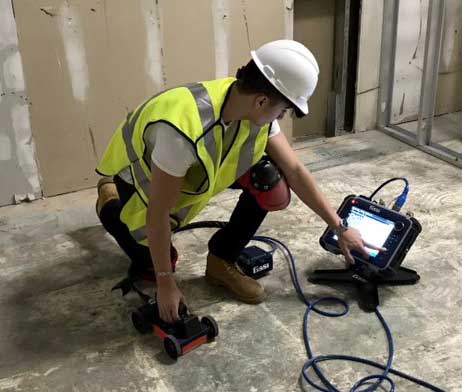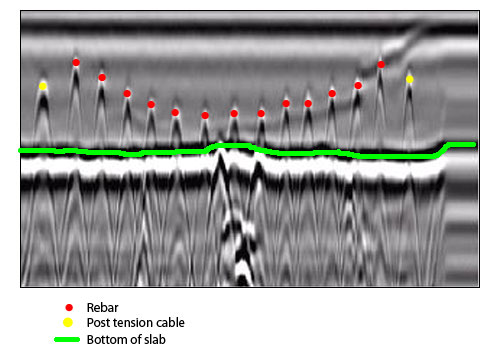The Importance of Precise Concrete Scanning in Finding Underground Hazards
In the world of building and infrastructure development, the value of specific concrete scanning can not be overemphasized. Below the seemingly strong ground lie complex networks of utilities, pipes, and various other subsurface structures that are usually undetectable to the naked eye. The capacity to properly discover and map these underground dangers is not simply an issue of comfort but a crucial facet of guaranteeing the safety of both building and construction workers and the honesty of the job itself. By deploying sophisticated scanning technologies and techniques, experts can reveal concealed risks, stop costly problems, and ultimately lead the way for smoother and more secure building and construction ventures.
Advanced Scanning Technologies for Detection
Innovative radar systems are revolutionizing the field of below ground detection by supplying unparalleled precision and effectiveness. These innovative scanning technologies use ground-penetrating radar (GPR) to produce in-depth images of subsurface frameworks, offering understandings into what exists underneath the surface area with impressive quality. By discharging high-frequency pulses right into the ground and gauging the representations, radar systems can recognize variants in product structure and find below ground dangers such as cables, voids, and pipelines.
Among the vital benefits of these sophisticated radar systems is their non-invasive nature, enabling for extensive evaluations without causing damages to the existing frameworks. This not only guarantees the safety of the surrounding setting yet likewise minimizes the need for pricey repair services or interruptions to ongoing construction tasks. Furthermore, the real-time data given by these scanning modern technologies allows quick decision-making and boosts general project performance.
Value of Subsurface Mapping

Exact subsurface mapping aids in stopping expensive damages to existing underground infrastructure, reducing the threat of crashes, and preserving job timelines. It enables project supervisors to make enlightened choices relating to site planning, tools release, and resource allotment. Additionally, subsurface mapping enables far better sychronisation among various groups working with a task and aids in adhering to regulatory needs connected to underground utility discovery.
Mitigating Dangers in Construction Tasks
Effective risk reduction methods are vital for guaranteeing the success and safety of building and construction projects. Recognizing and attending to potential threats before they escalate is vital in preserving task timelines, budget plans, and overall top quality. One essential facet of mitigating dangers in construction jobs is comprehensive preparation and assessment at the first stages. Carrying out comprehensive website surveys, consisting of exact concrete scanning for underground threats, can help in determining potential problems beforehand. Utilizing advanced modern technologies like ground-penetrating radar and electromagnetic induction can assist in discovering energies, rebar, or other obstructions that might pose risks throughout building and construction.
Furthermore, developing clear interaction channels among all project stakeholders and guaranteeing strict adherence to security procedures are crucial elements of danger reduction. Routine examinations, quality assurance actions, and surveillance of job progression can help in identifying and dealing with any emerging risks quickly. Additionally, having contingency plans in place for unanticipated obstacles can considerably decrease the impact of disruptions on the task. By proactively applying durable danger mitigation techniques, construction projects can decrease hold-ups, expense overruns, and security occurrences, eventually resulting in successful task results.

Stopping Pricey Damages and Delays
To decrease economic losses and job setbacks, reliable approaches should be executed to navigate to this website prevent pricey damages and hold-ups in building projects. Recognizing these obstructions early on helps in intending the project format a lot more efficiently and staying clear of prospective problems throughout excavation.
Additionally, purchasing training programs for building employees on the value of concrete scanning and safe excavation methods can considerably reduce the threat of accidents and delays. Clear communication networks between job managers, designers, and on-site employees are likewise necessary to ensure that everybody understands the possible risks and complies with the required procedures to avoid costly problems. By focusing on proactive procedures like concrete scanning and advertising a culture of security and recognition, construction jobs can decrease the financial impact of unforeseen below ground blockages and avoid costly delays.
Ensuring Safety And Security of On-Site Employee
By prioritizing proactive procedures such as thorough training programs and clear interaction channels, construction jobs can make sure the safety and security of on-site employees amid the potential risks found via concrete scanning. Correct training equips workers with the knowledge and skills needed to navigate construction sites safely, especially when risks are determined with scanning processes. Training ought to cover risk recognition, emergency procedures, and the proper utilization of personal protective tools to minimize threats properly.
In addition, developing clear interaction channels is vital for distributing info about identified risks promptly. This ensures that all on-site personnel recognize possible threats and can take essential preventative measures to prevent mishaps. Regular safety instructions, tool kit talks, and constant updates regarding scanning results aid maintain everybody informed and positive in maintaining a secure workplace.
In addition, carrying out stringent adherence to safety methods and policies, conducting routine safety audits, and cultivating a culture of safety awareness among employees are vital parts in guaranteeing the health of on-site workers throughout building projects - you can check here RainierGPR Concrete Scanning. Positive precaution not only secure employees from damage yet likewise add to the overall success and performance of the project
Final Thought
To conclude, exact concrete scanning Resources plays an important duty in finding underground dangers. Utilizing sophisticated scanning modern technologies and subsurface mapping helps minimize risks in building and construction projects, stopping pricey damages and hold-ups. By ensuring the security of on-site employees, accurate scanning can dramatically improve the effectiveness and success of building procedures. It is crucial for building and construction companies to prioritize the usage of exact scanning approaches to minimize prospective dangers and make sure a smooth building and construction process.
By proactively executing robust risk reduction methods, building projects can minimize hold-ups, expense overruns, and safety incidents, inevitably leading to effective job outcomes. - RainierGPR Concrete Scanning
To decrease economic losses and job problems, effective approaches have to be implemented to stop expensive damages and hold-ups in building and construction tasks. By focusing on proactive actions like concrete scanning and advertising a culture of safety and security and understanding, construction tasks can reduce the financial effect of unexpected below ground obstructions and prevent costly hold-ups.
By prioritizing positive measures such as detailed training programs and clear communication networks, construction jobs can make certain the security of on-site employees amidst the possible risks detected with concrete scanning. Making use of sophisticated scanning modern technologies and subsurface mapping helps alleviate threats in construction jobs, preventing costly problems and hold-ups.